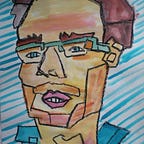Using Performance to Explore Feelings
Precis on 39 Microlectures: In Proximity of Performance by Matthew Goulish
I read this book because my friend loves it. It also sounded like it might have a structure similar to one of my own books.
It turns out that this book is definitely not for me! I found it interesting, just not very interesting.
What is This Book?
This is a book of feelings, bringing calm introspection and some degree of quiet to an addled mental life. Goulish makes no pretense to sort wrong ideas from right, and thus also indulges in much magical thinking: a book is the night, dreams flow through the body, cancer between all bodies is one. Groovy! Is there a reason why any of those is true? Not really. They’re just presented as propositions that can feel like a match for you or not.
To a large extent, the book is biographical, laying bare the author’s own struggles with learning, performance, and making sense of things.
This book is a bunch of things that are pleasing to read and consider, but sadly is little else. It can be a window to inspiration or a reminder to avoid pig paths of the mind (conventional thinking), but that’s it. I don’t see the value in this call to avoid conventions, myself, as conventions of thought are often highly rewarding and are more easily improved than they are tossed out completely.
Part of my frustration stems from the empirical and theoretical claims, which I almost invariably disagreed with. Goulish propagates the wrong idea that old windows have uneven thickness because glass flows, that a child can sometimes read a book and understand it without knowing how to read, and that all of our senses are always involved in every act of understanding. I generally mark an X in the margin when an author says something I think is straight up wrong. In this book, I had to stop marking Xs because there were too many.
Artistic Practice
What the book is hawking is intuitive creativity for emotional satisfaction, coupled with a few scruples of artistic self-discipline including intermittent care, reflection, confidence, immediacy, and iteration. A character in one story in this book summarizes this discipline inadvertently:
Yes we began working and had no ideas at all. Nothing makes sense, but we keep working and nobody tells us we’re doing anything wrong, and then at last something good starts to happen. We discuss possibilities, and we say, ‘What should it be? It can be anything. Should it be ball? No. Should it be car? No. Should it be Eiffel tower? Yes! And then everyone knows Eiffel Tower it is, but we don’t know why, and we go on, and it is right. It is like a miracle. (p 54)
I think this is almost universally recognized as good artistic practice, but is therefore also not very interesting to read. Goulish doesn’t even address discipline explicitly. His explicit claims are all sentimental concepts that one must become the gap in their understanding of a thing in order to understand it.
I would have preferred to read an experienced weird-art-pro weigh in on being accessible vs obscure, on rules vs risk in the performance space, how to use props without getting caught in the arms race of production value, etc. There are so many important practical and logistical problems in making freaky newness possible. I’d be happy to get some advice on any of them!
The Best Section
However, the final part of the book is the most interesting section of footnotes I’ve ever read. Goulish warns at the beginning that nearly everything he writes will be quotations from others who have said it before and better. Fine, sure, that’s true for anything.
But the footnotes section confirms this, providing the exact passages that he draws from in essentially every specific claim made in the entire book! The section goes on and on! You can see how his writing sometimes improves upon, but more often clumsily attempts to repeat, what has been written before. How humble and real! Much of his Deleuze and Whitehead is slightly tweaked and reimagined so that it no longer really works in the precise technical systems of each philosopher’s ouvre. But it all feels reasonable, in a humanist way that is just slightly too bizarre to be maudlin, and I see how that can make for a nice reading experience.
The book is, in fact, the text of lectures. Those lectures were delivered to people interested in pushing the envelope in performance. I imagine the performance of these lectures went well, as they mix high theory with tabloid headlines, stories, and quips from foreign writers. I just don’t personally find the content illuminating either for theory or artistic practice.
